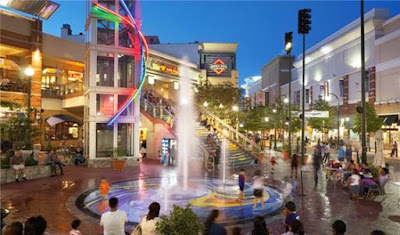Destinations where History is Still Being Made
Itineraries designed for American families and friends from abroad
interested in experiencing the past, present and future of industrial and commercial
development in key regions of the United States.
Several
American Communities are transitioning from traditional industrial
and commercial activities to technologically innovative ones; in some instances,
they are also able to re-establish their traditional economic activities with a
successful application of the so called knowledge economy and, in the process,
becoming once again competitive in the world marketplace.
There are several reasons why a community’s traditional economy can
succeed in a post-industrial environment. Among them are: the utilization of
modern communications technology, updating existing industrial infrastructure, training
of the local workforce and the participation of small businesses with the
support of local government that often leads to new entrepreneurial
opportunities as well.
Preserving
and Divulging a Community Cultural Heritage with Local Museums
The travel services industry often plays a key role in generating
economic multipliers in a community and Local Museums
contribute to local economic development and are a key point of reference in
telling the local story that links the past with the future:
 Baltimore was the first and
remains among the most successful efforts at redeveloping a downtown area. The Inner Harbor is
a major travel destination and home to a unique museum made up of historic ships that have served the
local community and the nation over time.
Baltimore was the first and
remains among the most successful efforts at redeveloping a downtown area. The Inner Harbor is
a major travel destination and home to a unique museum made up of historic ships that have served the
local community and the nation over time.
Nearby, Maryland’s Capital of Annapolis
is a great example of a small town with a tourism vocation as demonstrated by museums that
tell us about colonial America and life on the Chesapeake Bay.
 In Hershey, the Antique Automobile Club of America Museum
traces America’s love affair with the automobile and
its cultural and economic contributions, ranging from drive-in movies, to gas
stations, diners, shopping malls and long distance business and vacation
travel.
In Hershey, the Antique Automobile Club of America Museum
traces America’s love affair with the automobile and
its cultural and economic contributions, ranging from drive-in movies, to gas
stations, diners, shopping malls and long distance business and vacation
travel.
And out West, museums in Colorado Springs
help define a thriving arts and culture scene and retrace for us the many
industrial activities, from mining to construction and the Gold Rush, along
with a compelling story of transportation, from horses to rail – local and
intercity – to air and space.
Local
Food Wineries Breweries and a Travel Economy
There are several fascinating examples throughout America of a resurgence
in farming that cater to an ever increasing demand for local, quality and
sustainable food, wine and ale consumption:
In the Washington, DC area,
both in the US capital city and its suburban communities, a unique local
economy driven by government spending has also fueled the development of
downtown and neighborhood construction. This in turn has spawned a demand for
nightlife and weekend amenities for both a highly educated and environmentally
conscious local population and out of town visitors.
In the Maryland suburbs, the community of Silver Spring
has undergone such a transformation and is excellent base from which travelers
can take in the sights and monuments of the capital as well as the Potomac River Trails
and the coastal communities along Chesapeake Bay.
Similar experiences that provide a uniquely local eno-gastronomical atmosphere with historical and sustainable attractions are present in Southeastern Pennsylvania, in Philadelphia Neighborhoods and Hershey Harrisburg and the Susquehanna River Valley.
Arts Culture and the Environment
Some communities
have been in the forefront of land conservation, historic preservation, arts
movements that celebrates land and landscapes and water resources management
initiatives:
In the Lehigh Valley,
the local culture draws from the Moravian settlements experience in which all
men were equal; a broad cultural environment in which music, art, education and
religious tolerance flourished, as evidenced by the communal dwellings,
churches and industrial structures.
The Brandywine Valley, facing
an industrial development that would impact a largely rural community, focused
on Development & Conservancy
Issues, including floodplain areas that threatened to devastate
water supplies in parts of the Delaware River Valley. Local residents bought
endangered land and initiated conservation easements that now protect five and
one-half miles along the Brandywine River.
In the city
of Philadelphia, the waterfront is now a 6
mile walking and biking destination. Trail features include streetscape
improvements along the entire waterfront trail, a bi-directional bikeway,
pedestrian walkway and rain gardens that collect the first inch of storm water,
relieving the city sewer system during major weather events, as well as
benches, bike racks, decorative street pavers and innovative solar trail
lighting. Center City offers a thriving culture and entertainment scene as well
as contemporary arts museum with training programs and study
tours for students, aspiring artists and family traveling.
Dallas is the first ISO 14001 certified city in the US
- the international environmental standard which sets environmental goals for
organizations and communities – and among the first to adopt a green building
program that now boasts 5 LEED Gold, 1 LEED-EB Silver and 2 certified
buildings. New projects in the city include pedestrian-friendly parks such as
Main Street Garden, Belo Garden and the Klyde Warren Park. Dallas also is home to
the Trinity River Audubon Center, a LEED certified building with many
sustainable features: a vegetated roof, rainwater collection system, energy
efficient systems and recycled materials.









No comments:
Post a Comment